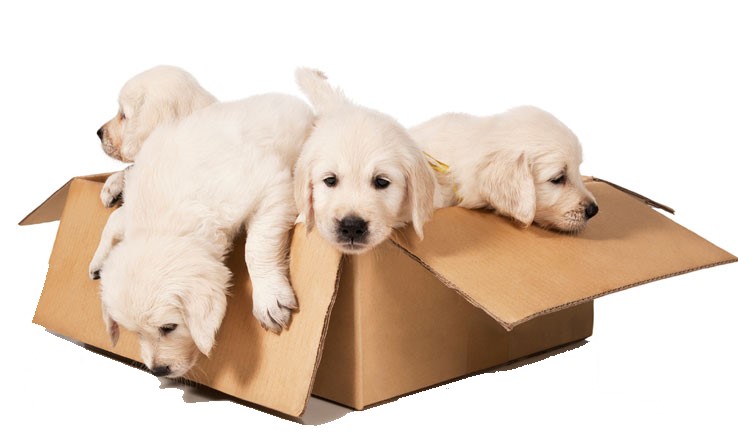In the United States, moving season is the period of time between Memorial Day and Labor Day—in essence, summer. As the season’s zenith approaches, hundreds of thousands of Americans around the country are packing up their lives for new jobs, new apartments, and first-time homeownership. Many of us have moved previously—to college, to a new city, into a first apartment. Many of us, however, haven’t gone through the experience of moving with a pet. The experience is markedly different and learning what’s typically involved is the best way to prepare for the event.
The moving process can be broken into four steps: searching for housing, packing, transportation, and unpacking/introduction. Below, we have included essential guides and tips to having a successful move—whether you’re moving down the street or across the country.
Finding Housing
The first step of the moving process is straightforward: you need to find a new place to live. If you’re moving into a new apartment or condominium, you will need to do some extra research to find pet-friendly housing. Some landlords ban animals outright, whereas others have restrictions on the size, breed, and number of pets you can have in the space. When searching for new housing, keep the following actions in mind.
- Be up-front about your pet. When using online apartment search tools, filter for “pet-friendly” to reduce your options. When you meet building owners and real estate agents, ask about pet policies and past experiences with pet owners. Never lie about owning a pet, and don’t try to hide an animal in an apartment. In the best-case scenario, you will need to get rid of the animal. In the worst-case scenario, you may be evicted or subject to other legal action for breaking the terms of your lease.
- Prepare to pay. Depending on your location, you may be asked to pay a pet fee, pet rent, or a higher security deposit. Save or factor this into your monthly budget to avoid unpleasant surprises. If a potential landlord is on the fence about allowing an animal in the building, offer to put down more money in the security deposit to show responsibility and accountability. Additionally, some building owners will require pet-related documentation: vaccination documents, dog licenses, a letter from a veterinarian, and/or a letter from your current property owner. Some of these items will cost money, but it is important to have them prepped and ready to go if you get approved for an apartment.
- Don’t put it off. Begin looking for housing as soon as you decide to move. Though it may be too early to find a home for your move-in date, do what you can to familiarize yourself with the buildings and availability in the area. If you find that most listings in one neighborhood are not pet friendly, continue looking in a different area. Finding a housing as early as possible will allow you to spend more time preparing yourself and your pets for the move.
Packing
Regardless of where you’re moving, you must always pack strategically. The process can take several weeks, providing both a physical and emotional burden for everyone in the house. Pets are also impacted by the packing process. It is therefore essential to consider their role in the process.
- Be strategic. Start early—two or three weeks before your moving day, and pack items you use least first. Starting with materials like china and books is a great way to get the process started. As boxes begin to pile up, store them in an inconspicuous area—the back room you never use, or perhaps the dining room table. Do what you can to keep the animals away from the boxes. They may see this new configuration of belongings as a toy; they might attempt to get into boxes, sit atop the pile, or otherwise hurt themselves or the belongings. Additionally, putting your boxes in a discreet spot allows the pets to continue living in the space normally, thus preventing stress build-up.
- Save pet equipment for the end. When you start to pack your animals will understand that something big is happening. Work on staving off stress and bad behavior by packing up their belongings last. Save items like food bowls, litter boxes, and toys for the end. Your pets will be able to use their things, and saving these items can allow for easy access during the moving process.
Transportation
Transportation is the most physically exhausting part of the moving experience. Whether you’re moving yourself or hiring professionals, you will need to drive you and your family (human or fur) to the new home. In some cases, this could mean a short trip up the block. In others, it might mean spending several days in a car, or perhaps several hours on an airplane. Smart transportation is key to a safe moving experience, and preparing your pet for travel is the best strategy for a smooth transition.
- Secure everything in advance. If you plan to fly to your new home, book your tickets as early as possible. Most airlines limit the number of pets on each flight, so securing your animal’s spot is essential for a safe move. Airline pet policies vary, so do your research to see what restrictions apply. In some cases, shipping a pet may be the easiest and safest option. Some airlines provide shipping services; use our guide to determine which provider will work best for your move.
- Double-check pet-friendly hotel policies. Those driving to their new homes may spend several days in the car. Carefully plan your overnight stops to include hotels with friendly pet-policies. For added safety, call ahead to verify advertised policies to ensure that you and your furry friends will be able to spend the evening. When staying at a hotel, do your best to keep the animals confined to one part of the room, and place food, water, and litterboxes in the bathroom to avoid possible cleaning fees.
- Consider your options. Sometimes, the best transportation option may be obvious. Other times, you may struggle to figure out which will work for your situation. Remember that cats and dogs respond to travel differently, and there are several pet-friendly transportation providers available—airlines, trains, and car rentals. Consider every possible method before deciding on a strategy.
Introduction
You’ve found a place, packed up your belongings, and transported everything to your new home. Now, the fun part begins. You may be tempted to let your pets out immediately, but remain vigilant and wary of hidden dangers. Use the first few minutes after your arrival to get the animals outside of the car. Then, follow these five steps to ensure an easy and safe introduction.
- Move slowly to avoid overstimulation.
- Prioritize safety by locking the animals in a room while you check for potential dangers.
- Unload strategically by placing boxes into their appropriate rooms.
- Emphasize comfort by putting pet items in familiar locations.
- Unpack quickly to prevent potentially dangerous pet situations, such as open boxes.
When done strategically and with proper planning, moving with a pet can be a productive experience. Before the process, consider every option and variable—from the type of housing and your timeline to transportation and unpacking procedures. Then, work to support your pet throughout the journey. A successful move and home introduction is key to a happy and healthy post-move life.




